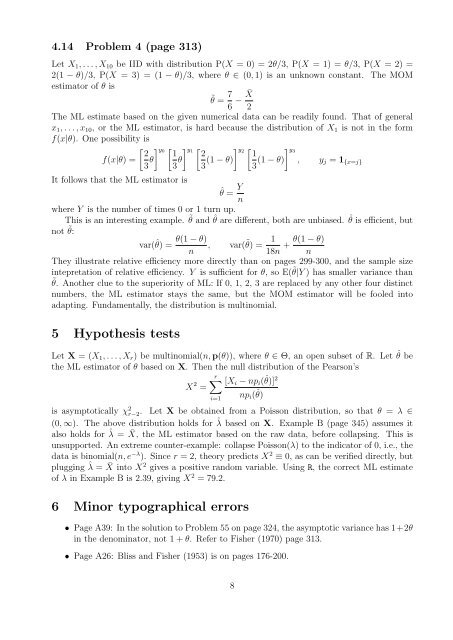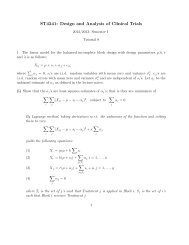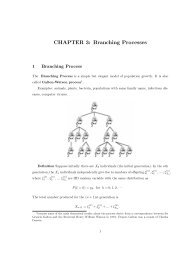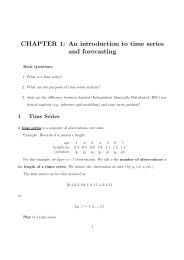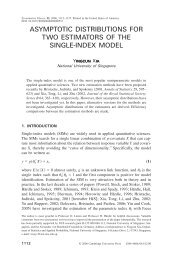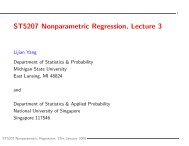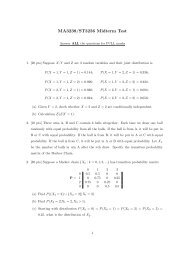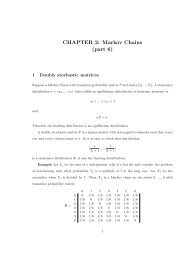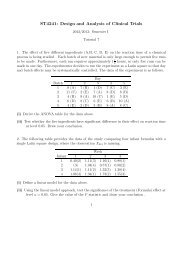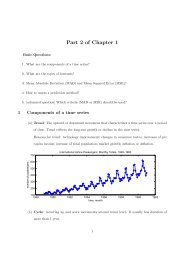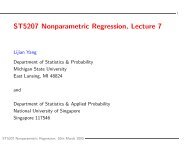Companion notes - The Department of Statistics and Applied ...
Companion notes - The Department of Statistics and Applied ...
Companion notes - The Department of Statistics and Applied ...
You also want an ePaper? Increase the reach of your titles
YUMPU automatically turns print PDFs into web optimized ePapers that Google loves.
4.14 Problem 4 (page 313)<br />
Let X 1 , . . . , X 10 be IID with distribution P(X = 0) = 2θ/3, P(X = 1) = θ/3, P(X = 2) =<br />
2(1 − θ)/3, P(X = 3) = (1 − θ)/3, where θ ∈ (0, 1) is an unknown constant. <strong>The</strong> MOM<br />
estimator <strong>of</strong> θ is<br />
˜θ = 7 6 − ¯X<br />
2<br />
<strong>The</strong> ML estimate based on the given numerical data can be readily found. That <strong>of</strong> general<br />
x 1 , . . . , x 10 , or the ML estimator, is hard because the distribution <strong>of</strong> X 1 is not in the form<br />
f(x|θ). One possibility is<br />
[ ] y0<br />
[ ] y1<br />
[ ] y2<br />
[ ] y3<br />
2 1 2 1<br />
f(x|θ) =<br />
3 θ 3 θ 3 (1 − θ) 3 (1 − θ) , y j = 1 {x=j}<br />
It follows that the ML estimator is<br />
ˆθ = Y n<br />
where Y is the number <strong>of</strong> times 0 or 1 turn up.<br />
This is an interesting example. ˜θ <strong>and</strong> ˆθ are different, both are unbiased. ˆθ is efficient, but<br />
not ˜θ:<br />
θ(1 − θ)<br />
var(ˆθ) = , var(˜θ) = 1 θ(1 − θ)<br />
+<br />
n<br />
18n n<br />
<strong>The</strong>y illustrate relative efficiency more directly than on pages 299-300, <strong>and</strong> the sample size<br />
intepretation <strong>of</strong> relative efficiency. Y is sufficient for θ, so E(˜θ|Y ) has smaller variance than<br />
˜θ. Another clue to the superiority <strong>of</strong> ML: If 0, 1, 2, 3 are replaced by any other four distinct<br />
numbers, the ML estimator stays the same, but the MOM estimator will be fooled into<br />
adapting. Fundamentally, the distribution is multinomial.<br />
5 Hypothesis tests<br />
Let X = (X 1 , . . . , X r ) be multinomial(n, p(θ)), where θ ∈ Θ, an open subset <strong>of</strong> R. Let ˆθ be<br />
the ML estimator <strong>of</strong> θ based on X. <strong>The</strong>n the null distribution <strong>of</strong> the Pearson’s<br />
r∑<br />
X 2 [X i − np i (ˆθ)] 2<br />
=<br />
np i (ˆθ)<br />
i=1<br />
is asymptotically χ 2 r−2. Let X be obtained from a Poisson distribution, so that θ = λ ∈<br />
(0, ∞). <strong>The</strong> above distribution holds for ˆλ based on X. Example B (page 345) assumes it<br />
also holds for ˆλ = ¯X, the ML estimator based on the raw data, before collapsing. This is<br />
unsupported. An extreme counter-example: collapse Poisson(λ) to the indicator <strong>of</strong> 0, i.e., the<br />
data is binomial(n, e −λ ). Since r = 2, theory predicts X 2 ≡ 0, as can be verified directly, but<br />
plugging ˆλ = ¯X into X 2 gives a positive r<strong>and</strong>om variable. Using R, the correct ML estimate<br />
<strong>of</strong> λ in Example B is 2.39, giving X 2 = 79.2.<br />
6 Minor typographical errors<br />
• Page A39: In the solution to Problem 55 on page 324, the asymptotic variance has 1+2θ<br />
in the denominator, not 1 + θ. Refer to Fisher (1970) page 313.<br />
• Page A26: Bliss <strong>and</strong> Fisher (1953) is on pages 176-200.<br />
8


